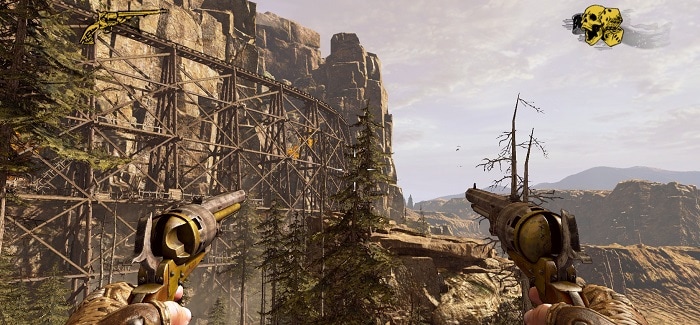|
With its heady mix of the fact, fiction and folklore of the American frontier, the Western has been a popular genre for over a century. Detailing the dubious exploits of bounty hunter Silas Greaves, Techland's 2013 FPS Call of Juarez: Gunslinger is a brilliant and under-recognised exploration of the Old West. By 2013, the Call of Juarez series had picked up a very bad reputation indeed. The most recent game at the time, subtitled The Cartel, had become notorious for its poor quality and numerous technical issues. Many were surprised to learn that Polish developer Techland hadn't abandoned the franchise altogether. For its part, Gunslinger was released as an inexpensive download-only title and afforded very little promotion. It looked like another disappointment in the making - but while it didn't make many waves in its release, it won deservedly strong reviews. Techland made some bold choices for Gunslinger. The present-day setting of The Cartel was dropped, but there was no attempt to connect narratively with the earlier games in the series. Indeed, the Mexican city of Juarez does not even feature in the game.
Instead, Gunslinger has its basis in the great mythos of the Old West itself. It draws liberally not only from both American and Italian Western films, but also from the vast body of historical fact, legend, and supposition that has built up around the American frontier. Its levels are set across numerous states over a period of decades, and involve a whole rogues gallery of the most notorious figures of the time, from Billy the Kid to the Wild Bunch. The real masterstroke of Gunslinger is the way its story is told - in a hazy, unreliable stream of claims which reflect our changeable and uncertain view of the Old West. To set up a frame narrative, the player character, rides into the Kansas town of Abilene in 1910. In a saloon there, Silas Greaves holds court before a small cast of largely unseen characters. Spurred on by their curiosity and numerous free drinks, the old man regales them with tales of his long life as a gunslinger. These episodes make up the levels of the game, and their dubious and unreliable nature have a profound impact on gameplay. When Silas says a convenient escape route "appeared before his eyes", this is exactly what happens to the player. When one of the saloon drinkers points out that a course of action Silas considered would have resulted in his death, the game rewinds, and the old bounty hunter explains the decision he really made. And like all the best tall tales, nothing that Silas says can be disproven by his listeners. Like so much of the Old West, Silas and his story exists in the grey area where fact and legend collide. The gunslinger is so personable and self-deprecating, his cause so just, that his audience and the player are willingly caught up in his breathless mix of drunken, half-remembered, possibly invented but brilliantly exciting adventures. Completing the effect is the excellent presentation of Gunslinger. While linear, the game captures the rough-hewn beauty of the West and its period-appropriate music is perfectly suited to the atmosphere. The gunplay is surely among the best in FPS history, a fantastic mix of rapid-fire targeting and satisfying trick shots. But four years on, it's the wonderful narrative which makes Gunslinger a truly special FPS - and one which, remarkably, has something to say about the romantic myth and the reality of the Old West.
0 Comments
Your comment will be posted after it is approved.
Leave a Reply. |
About
Exploring classic science fiction, with a focus on the 1950s to the 1990s. Also contributing to Entertainium, where I regularly review new games. Categories
All
|

